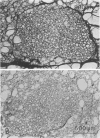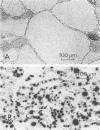Abstract
Pathogenesis of nodule formation was studied in over 100 nodular goiters from a subendemic area. 60 surgical specimens were autoradiographed. Only one classical, well-encapsulated adenoma was detected. All other nodules were incompletely encapsulated and consisted of follicles that were morphologically and functionally identical to those of nonnodular parenchyma. Most characteristic was the tremendous interfollicular heterogeneity appearing on autoradiographs. Nodular goiters contain multiple foci and strands of fibrous tissue, which result from scarring of multiple hemorrhagic necroses occurring during goiter growth. Therefore, the slowly growing number of newly formed follicles has to squeeze into the meshes of an inelastic network of connective tissue. Nodular growth pattern is the inevitable consequence. Some particular nodules expand because of excessive accumulation of colloid. We conclude that most thyroid nodules in long-standing goiters consist of ordinary, polyclonal goiter follicles which expand in nodular fashion because they replicate within a mold made out of a poorly extensible network of connective tissue.
Full text
PDF








Images in this article
Selected References
These references are in PubMed. This may not be the complete list of references from this article.
- Burke G., Szabo M. Dissociation of in vivo and in vitro "autonomy" in hyperfunctioning thyroid nodules. J Clin Endocrinol Metab. 1972 Aug;35(2):199–202. doi: 10.1210/jcem-35-2-199. [DOI] [PubMed] [Google Scholar]
- CLEMENTS F. W. Health significance of endemic goitre and related conditions. Monogr Ser World Health Organ. 1960;44:235–260. [PubMed] [Google Scholar]
- DeRubertis F., Yamashita K., Dekker A., Larsen P. R., Field J. B. Effects of thyroid-stimulating hormone on adenyl cyclase activity and intermediary metabolism of "cold" thyroid nodules and normal human thyroid tissue. J Clin Invest. 1972 May;51(5):1109–1117. doi: 10.1172/JCI106903. [DOI] [PMC free article] [PubMed] [Google Scholar]
- Feder N. Solitary cells and enzyme exchange in tetraparental mice. Nature. 1976 Sep 2;263(5572):67–69. doi: 10.1038/263067a0. [DOI] [PubMed] [Google Scholar]
- Ferriman D., Hennebry T. M., Tassopoulos C. N. True thyroid adenoma. Q J Med. 1972 Apr;41(162):127–139. [PubMed] [Google Scholar]
- Fialkow P. J. The origin and development of human tumors studied with cell markers. N Engl J Med. 1974 Jul 4;291(1):26–35. doi: 10.1056/NEJM197407042910109. [DOI] [PubMed] [Google Scholar]
- Field J. B., Larsen P. R., Yamashita K., Mashiter K., Dekker A. Demonstration of iodide transport defect but normal iodide organification in nonfunctioning nodules of human thyroid glands. J Clin Invest. 1973 Oct;52(10):2404–2410. doi: 10.1172/JCI107430. [DOI] [PMC free article] [PubMed] [Google Scholar]
- Folkman J. Tumor angiogenesis. Adv Cancer Res. 1974;19(0):331–358. doi: 10.1016/s0065-230x(08)60058-5. [DOI] [PubMed] [Google Scholar]
- Gartler S. M., Gansini E., Hutchison H. T., Campbell B., Zechhi G. Glucose-6-phosphate dehydrogenase mosaicism: ito;ozatopm om tje study of hair follicle variegation. Ann Hum Genet. 1971 Jul;35(1):1–7. [PubMed] [Google Scholar]
- Geiser J., Bürgi H., Grob P. J., Studer H. Bedeutung der Schilddrüsenkrankheiten in einer allgemein-internistischen Klinik. Schweiz Med Wochenschr. 1978 Jul 29;108(30):1152–1156. [PubMed] [Google Scholar]
- Gerber D. Schilddrüsengewichte und Jodsalzprophylaxe. Vergleichende Untersuchung am Sektionsgut des Instituts für Pathologic der Universität Zürich. Schweiz Med Wochenschr. 1980 Dec 27;110(52):2010–2017. [PubMed] [Google Scholar]
- Gerber H., Studer H., Conti A., Engler H., Kohler H., Haeberli A. Reaccumulation of thyroglobulin and colloid in rat and mouse thyroid follicles during intense thyrotropin stimulation. A clue to the pathogenesis of colloid goiters. J Clin Invest. 1981 Nov;68(5):1338–1347. doi: 10.1172/JCI110381. [DOI] [PMC free article] [PubMed] [Google Scholar]
- Haeberli A., Studer H., Kohler H., Bürgi H., Engler H. Autoradiographic localization of slow turnover iodocompounds within the follicular cells of the rat thyroid gland. Endocrinology. 1975 Oct;97(4):978–984. doi: 10.1210/endo-97-4-978. [DOI] [PubMed] [Google Scholar]
- Kalderon A. E., Sheth V. Secretion and adenylate cyclase in thyroid nodules. Arch Pathol Lab Med. 1978 Jul;102(7):381–386. [PubMed] [Google Scholar]
- Larsen P. R., Yamashita K., Dekker A., Field J. B. Biochemical observations in functioning human thyroid adenomas. J Clin Endocrinol Metab. 1973 May;36(5):1009–1018. doi: 10.1210/jcem-36-5-1009. [DOI] [PubMed] [Google Scholar]
- Lupulescu A. P., Boyd C. B. Follicular adenomas. An ultrastructural and scanning electron microscopic study. Arch Pathol. 1972 Jun;93(6):492–502. [PubMed] [Google Scholar]
- Matthaes P., Niemann T., Kauffmann-Mackh G. Ultrastrukturelle Zellveränderungen in der Jodfehlverwertungsstruma und im follikulären Adenom. Virchows Arch A Pathol Pathol Anat. 1972;356(1):58–65. [PubMed] [Google Scholar]
- Miller J. M., Horn R. C., Block M. A. The autonomous functioning thyroid nodule in the evolution of nodular goiter. J Clin Endocrinol Metab. 1967 Sep;27(9):1264–1274. doi: 10.1210/jcem-27-9-1264. [DOI] [PubMed] [Google Scholar]
- Pisarev M. A., Kleiman de Pisarev D. L. Biochemistry of thyroid regulation under normal and abnormal conditions. J Endocrinol Invest. 1980 Jul-Sep;3(3):317–329. doi: 10.1007/BF03348284. [DOI] [PubMed] [Google Scholar]
- Rentsch H., Studer H., Frauchiger B., Siebenhüner L. Topographical heterogeneity of basal and thyrotropin-stimulated adenosine 3'5'-monophosphate in human nodular goiter. J Clin Endocrinol Metab. 1981 Sep;53(3):514–521. doi: 10.1210/jcem-53-3-514. [DOI] [PubMed] [Google Scholar]
- Schmid M., Schulthess C., Bürgi H., Studer H. Jodmangel ist in der Schweiz noch immer endemisch. Schweiz Med Wochenschr. 1980 Sep 6;110(36):1290–1295. [PubMed] [Google Scholar]
- Steck A., Steck B., König M. P., Studer H. Auswirkungen einer verbesserten Jodprophylaxe auf Kropfendemie und Jodstoffwechsel. Schweiz Med Wochenschr. 1972 Jun 17;102(24):829–837. [PubMed] [Google Scholar]
- Studer H. A fresh look at an old thyroid disease: euthyroid and hyperthyroid nodular goiter. J Endocrinol Invest. 1982 Jan-Feb;5(1):57–68. doi: 10.1007/BF03350484. [DOI] [PubMed] [Google Scholar]
- Studer H., Hunziker H. R., Ruchti C. Morphologic and functional substrate of thyrotoxicosis caused by nodular goiters. Am J Med. 1978 Aug;65(2):227–234. doi: 10.1016/0002-9343(78)90813-6. [DOI] [PubMed] [Google Scholar]
- Studer H., Ramelli F. Simple goiter and its variants: euthyroid and hyperthyroid multinodular goiters. Endocr Rev. 1982 Winter;3(1):40–61. doi: 10.1210/edrv-3-1-40. [DOI] [PubMed] [Google Scholar]
- TAYLOR S. Genesis of the thyroid nodule. Br Med Bull. 1960 May;16:102–105. doi: 10.1093/oxfordjournals.bmb.a069806. [DOI] [PubMed] [Google Scholar]
- TAYLOR S. The evolution of nodular goiter. J Clin Endocrinol Metab. 1953 Oct;13(10):1232–1247. doi: 10.1210/jcem-13-10-1232. [DOI] [PubMed] [Google Scholar]
- Toccafondi R. S., Rotella C. M., Tanini A., Fani P., Arcangeli P. Thyrotrophin-responsive adenylate cyclase activity in thyroid toxic adenoma. Acta Endocrinol (Copenh) 1979 Dec;92(4):658–668. doi: 10.1530/acta.0.0920658. [DOI] [PubMed] [Google Scholar]
- Wadeleux P. A., Winand R. J. Some unexpected effects of thyrotrophin on the metabolism of thyroid cells isolated from non-toxic goitre. Acta Endocrinol (Copenh) 1981 Dec;98(4):533–539. doi: 10.1530/acta.0.0980533. [DOI] [PubMed] [Google Scholar]















